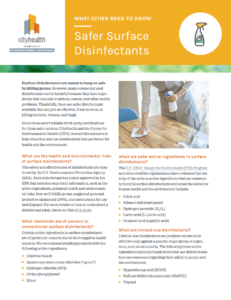
Surface disinfectants are meant to keep us safe by killing germs.
However, many commonly used disinfectants can be harmful because they have ingredients that can lead to asthma, cancer, and other health problems. Thankfully, there are safer disinfectants available that are just as effective, if not more so, at killing bacteria, viruses, and fungi.
Since there aren’t reliable third-party certifications for these safer options, CityHealth and the Center for Environmental Health (CEH) created this resource to help cities find and use disinfectants that are better for health and the environment.


Produced in partnership with the Center for Environmental Health
Technical expertise provided by the Responsible Purchasing Network
What are the health and environmental risks of surface disinfectants?
The safety and effectiveness of disinfectants are monitored by the U.S. Environmental Protection Agency (EPA). Each disinfectant has a label approved by the EPA that includes important information, such as the active ingredients, potential health and environmental risks, how well it kills germs, suggested personal protective equipment (PPE), and instructions for use and disposal. For more details on how to understand a disinfectant label, check out this EPA guide.
What chemicals are of concern in conventional surface disinfectants?
Certain active ingredients in surface disinfectants are of particular concern due to their negative health impacts. We recommend avoiding products with the following active ingredients:
- Chlorine bleach
- Quaternary ammonium chlorides (“quats”)
- Hydrogen chloride (HCl)
- Ortho-phenylphenol
- Silver
What are safer active ingredients in surface disinfectants?
The U.S. EPA’s’ Design for Environment (DfE) Program and other credible organizations have evaluated the toxicity of the various active ingredients that are commonly found in surface disinfectants and noted the safest for human health and the environment include:
- Citric acid
- Ethanol and isopropanol
- Hydrogen peroxide (H2O2)
- Lactic acid (L-Lactic acid)
- Octanoic acid (caprylic acid)
What are limited-use disinfectants?
Limited-use disinfectants are products shown to be effective only against a specific major group of organisms, such as salmonella. The following three active ingredients typically found in limited-use disinfectants have no consensus regarding their safety to people and the environment:
- Hypochlorous acid (HOCl)
- Sodium dichloroisocyanurate (NaDCC)
- Thymol
What are the recommended specifications for safer surface disinfectants?
Minimum Requirements
The product must be registered by the US Environmental Protection Agency (U.S. EPA) and be on the U.S. EPA’s List N: Disinfectants for Coronavirus (COVID-19).
The only active ingredients the product may contain:
- Citric acid
- Ethanol/Isopropanol
- Hydrogen peroxide
- Lactic acid (L-Lactic acid)
- Octanoic acid (Caprylic acid)
The product may not be in an aerosol container.
Additional Desirable Attributes
The product is certified by U.S. EPA’s Design for the Environment (DfE) Program; a list of DfE-certified disinfectants can be accessed here.
- The product is concentrated and designed for use in an automatic dilution system to ensure perfect water to product ratio with each use.
- Product packaging is designed for a closed loop system meaning it can be reused or turned into new products after use.
- The product is free of dyes and fragrances.
What are best practices for using safer surface disinfectants?
The following are best practice guidelines for using safer disinfectants.
- Adopt a green cleaning and safe disinfection purchasing policy that utilizes the recommended specifications.
- Identify which surfaces need disinfecting versus the ones that need cleaning and use this information to create a targeted purchasing policy.
- Always clean first, then disinfect.
- Use disinfectants properly and safely based on the EPA-approved label instructions.
- Consider concentrated products in a closed-loop package that pair with automatic dilution equipment.
- Provide regular training to your jurisdiction’s custodial staff and service providers.
- Avoid using foggers and misters to apply disinfectants.
- Avoid using disinfecting wipes, whenever possible
- Publicize your green cleaning accomplishments to serve as a model for other communities.
